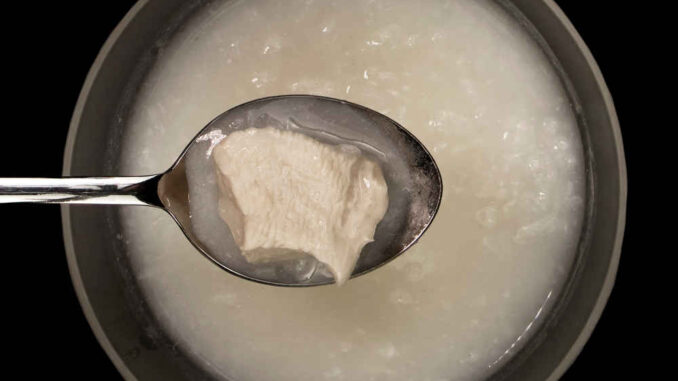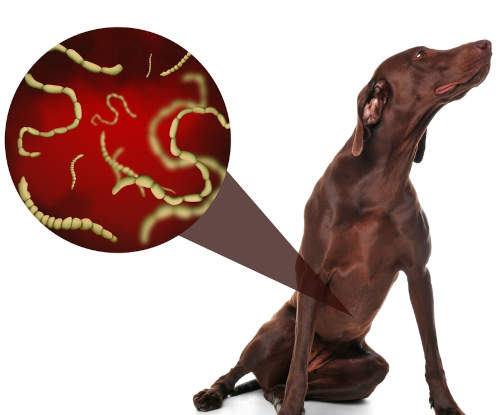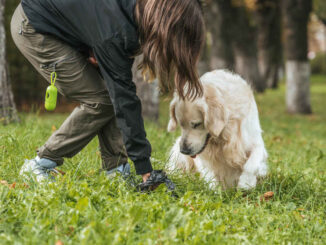
This article was updated on December 3rd, 2023

As a veterinarian, I’m no stranger to blood in a dog’s stool. Some days, it may seem like that’s all I see!
Seeing bright red blood in your dog’s poop can be scary, but it doesn’t always need immediate veterinary attention. Mild cases can be treated at home with some not-so-secret remedies that I will let you in on.
While some cases can be taken care of at home, it’s important to always consult your veterinarian before trying any treatment. Your vet should be kept in the loop throughout the process should you need any additional advice or diagnostics.
Home remedies for blood in a dog’s stool
If your dog’s bloody stool is just that and they’re not showing any other signs of lethargy, vomiting, fever, stomach pain, straining, or you don’t see any worm eggs in the feces, you may choose to watch, wait, and treat at home. Here are a few options of at-home treatments:
1. Rest: When something is off in the body, the best medicine is rest and relaxation. Find them a quiet spot where they can do just that.
2. Stay hydrated: Dehydration is a common issue with anything related to the digestive system. Encourage your dog to drink water by offering plenty of fresh and clean options or by mixing in a little low-sodium chicken broth or unflavored Pedialyte.
3. Withhold food: Give your dog’s digestive system a break by withholding food for about 12 hours. This will just allow what’s in there to move out without adding additional work.
4. Bland diet: After the initial 12 hours of withholding food, get their digestive system back up and running with some boiled chicken and rice with no seasonings. Feed them anywhere from 1 tablespoon to ¼ cup, depending on their size, every 3-4 hours. To learn more, read my article featuring 11 easy bland diet options for dogs.
5. Probiotics: Replenish your dog’s microbiome with probiotics. Fortiflora and Probios are good options, as you want organisms that are specifically found in the dog’s gi tract.
6. Fiber: Boosting your dog’s fiber can help your dog’s digestive tract move things through in order to get rid of any offending substances, and it helps bulk up bowel movements to help express anal glands. Canned pumpkin or low-sodium canned green beans are a great way to incorporate a little more fiber.
How fast should my dog recover?
Most mild cases of bloody stools in dogs will resolve within 24-48 hours. You may want to continue feeding your dog a bland diet for a couple of days past the last bloody bowel movement just to make sure everything is calmed down digestively. You can then gradually transition your dog back to their regular diet.
If your dog is starting to make a habit out of occasional bloody stools, you may consider changing their dog food to a novel protein or more easily digestible diet. Your veterinarian can help you wade through the sea of possibilities to find the right one.
If, during your at-home treatment, your dog starts to show any other signs or if the blood gets worse or doesn’t go away within 48 hours, it’s time to make the vet appointment.
Is a trip to the vet necessary?
Blood in a dog’s stool can be very frightening, especially if it’s accompanied by any other signs. Vomiting, diarrhea, and not eating lasting longer than 24 hours, dehydration, fever, lethargy, or any signs that seem overly severe should all be seen by a vet.
Not every bloody bowel movement is going to require a trip to the vet. Some mild cases that only happen once or twice without any other symptoms may resolve in their own with a little home care. It’s still a good idea to consult with your vet when trying at-home remedies so that they can give you personalized advice and be aware of what is going on with your pup.
When to call the vet
The occasional bloody bowel movement without other symptoms is usually no big deal. However, if you also see other signs of illness such as vomiting, lethargy, a decreased appetite, stomach pain, straining, or a fever, see your veterinarian.
If there is blood in the stool for longer than 48 hours, even with trying the at-home treatments, see your veterinarian. Don’t hesitate to make an appointment anytime you’re worried or uncomfortable.
Why does my dog have blood in their stool?
The cause of your dog’s bloody poop is going to make a huge difference in how it is treated and whether at-home treatments are even an option. Getting to the root of the problem, if possible, is an important first step. Feel free to take a more in-depth look by reading our article about bloody dog poop. Now, onto those potential causes.
Less serious causes may be attributed to:
1. Internal parasites
Worms that live in a dog’s digestive tract attach themselves to the inner walls of the intestines. If there are a lot of worms setting up shop in your dog, it can lead to bleeding that comes out as bloody stool. A heavy worm load may also cause weight loss and a dull hair coat, and you may see worms or eggs mixed in with the feces.

2. Eating something they shouldn’t have
Dogs love to explore their world with their mouth, making eating things that don’t agree with them very common. Rotten food, animal feces, human food, etc., can all cause bloody stools in dogs. They may also not want to eat if they have vomiting, diarrhea, and stomach pain. Most of the time, dogs will get over this within a couple of days, but it can become more serious.
3. Stress
Stress affects our canine companions too! Changes in their environment, separation, or other illnesses can cause stress that leads to bloody diarrhea. Dogs may also be anxious, have abnormal behaviors, and not want to eat.
4. Anal gland issues
The anal glands are located just inside the rectum and any inflammation or impaction of them can leave bloody streaks on your dog’s poop. Dogs may also strain to defecate or scoot their bottom on the ground.
More serious potential causes for bloody stool in dogs are:
5. Inflammation of the digestive tract
Viral and bacterial infections, stress, autoimmune diseases, and other systemic issues, like kidney or liver disease, can lead to bloody stools in dogs. Some may be mild, others more severe. Watch out for other signs of illness including vomiting, diarrhea, fever, not eating, and stomach pain.
6. Cancer
Tumors growing anywhere in the digestive tract can lead to bleeding. Weight loss, abdominal pain, not eating, and lethargy may accompany.
7. Toxins
Poisonous plants, cleaning supplies, or lawn chemicals can cause bloody stool if your dog ingests them. If you suspect your dog ate something toxic, contact your vet right away.
Veterinary treatments
Your vet’s going to start with a thorough exam. Hopefully, you have kept them in the loop so that they know when the bloody stools started, how frequent they are, and if your dog is showing any other signs. If possible, bring along a sample so that your vet can see the bloody stool and run tests to check for parasites and other issues.
From there, your vet may want to run some blood work, do some imaging, or express the anal glands. They may prescribe medications or a special diet, depending on their findings.
FAQs
Can stress cause blood in a dog’s stool?
Yes, stress can cause inflammation in the intestine that leads to leakiness, which can put blood and excessive fluid or mucous in the stool. Dogs can experience stress from changes in their environment, anxiety from your leaving, or health issues.
Will scrambled eggs help resolve blood in my dog’s stool?
Scrambled eggs are a good protein source and are easily digestible, so they can be a good choice for dogs with bloody stools. While they probably won’t help resolve the blood, they can be incorporated as part of a bland diet. Just make sure to leave out the seasonings.
Is feeding my dog bananas a good idea to treat bloody stools?
Bananas are high in fiber, which can help with cases of bloody diarrhea. However, you don’t want to overdo it. Just mix a few slices in with the rest of their bland diet.
Can yogurt provide relief?
Yogurt is full of probiotics, which are good bacteria that live in the digestive tract and help with digestion. Issues that can cause bloody stool can also cause an upset in the normal bacterial balance. Giving foods that are high in probiotics, like yogurt, may help restore that balance; however, it is preferable to use a product that contains specific dog gi tract enzymes. If you try yogurt, make sure to give plain, unflavored yogurt to avoid giving too much sugar.
Should I feed my dog rice?
A bland, easily digestible diet is recommended for bloody stools since it gives the digestive tract a break and allows it to heal. Rice is a good choice since it provides the carbohydrates that a dog needs for energy but is also easily digested.
Related posts:
Disclaimer: This website's content is not a substitute for veterinary care. Always consult with your veterinarian for healthcare decisions. Read More.









Be the first to comment